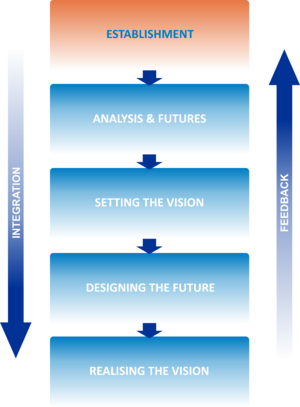Integrating Climate Change into the ICZM planning process - Establishment
| Introduction |
|
Establishment |
|
Analysis and Futures |
|
Setting the Vision |
|
Designing the Future |
|
Realising the Vision |
|
Contents
This is an important stage of the ICZM process. The aim is to set out an operational foundation for the subsequent preparation of the strategy or plan and its implementation, to begin the process of understanding the challenges facing the area and the differing perceptions of those challenges, and to begin building a constituency of support for the strategy or plan.
As far a climate change is concerned, the main concern is to ensure that there is institutional coordination with bodies responsible for climate adaptation and mitigation strategies and plans. All countries have an obligation to produce a communication to the United National Framework Convention on Climate Change, detailing greenhouse gas emissions (GHGs), as well as vulnerability assessments and some actions to adapt to climatic changes. Thus from the outset any actions on climate change under the ICZM should be coordinated with the National Communication Office of the country. In addition, local authorities in many coastal zones are already planning to introduce measures to respond to some of the expected impacts of climate change. It is essential that these authorities and their plans and procedures be brought into the ICZM process at this initiation stage.
Establishing coordination mechanisms
The IMF document identified three groups that constitute the governance structure for the ICZM: the steering group, the technical group and the consultative group. As far as climate change is concerned, its mainstreaming requires the following:
- At least one representative from national government or the higher-level competent local administration(s) should have familiarity with climate issues, possibly because s/he is involved in one of the other bodies dealing with this topic.
- The technical group needs at least one person with working knowledge of adaptation to climate change
- The consultative group should include someone from the National Communication Office as well as representative from all sectors where climate issues have been assessed as being important at stage 1.4 Scoping
The governance structure is decided during the preparation of the national ICZM strategy and implemented in drawing up the national and local plans.
Defining territorial scope
Climatic changes will have impacts on areas that do not respect the boundaries of a coastal zone as defined in the ICZM. Sea level rise, for example may well affect areas outside the defined zone, and extreme events could impact on areas that extend beyond the defined boundaries, yet are part of an integrated area that includes the coastal zones.
As the IMF document states, it is necessary to be practical in defining the territorial scope of the areas to be covered under the plan. The ‘competent’ coastal units should be reconciled with the ecosystem, economic, social and political criteria as appropriate. This also applies to maritime zones, where the economic and social criteria should be applied, including coastal tourism, culture, agriculture and economic uses, but also includes patterns of transport and accessibility and urbanisation. In general it makes sense to retain the use of administrative boundaries where possible to maintain the integrity of stakeholder accountability and recognition, policy conformity and statistical information. A pragmatic compromise of ecosystem and administration is required.
The issue of boundary definitions is something to be brought up during the preparation of the national ICZM strategy, with, in our opinion, a pragmatic view as outlined above being the recommended approach. When the national plan is being prepared more details should be provided on how to deal with conflicts between administrative definitions and ecological, economic, social and political zones. Some resolution of these conflicts should be proposed in the National Plan. The local plans should then work with the agreed boundary definitions.
Defining governance context
As noted at the outset, the institutional context for climate change planning is already well established. In addition to the National Communication Office, and local and regional governments that are considering actions to adapt to climate change, several line ministries and departments have some involvement. These include:
- Ministry of Agriculture, for possible impacts in terms of crop yields Ministry of Environment, especially the Department dealing with water management and ecosystem health
- Ministry of Health, dealing with consequences of heat waves, vector and water borne
diseases and increased risks of food contamination with higher temperatures
- Departments responsible for land classification (local and central).
- Ministry of Tourism


